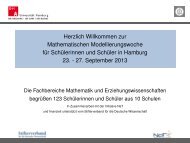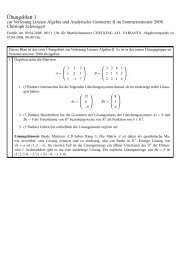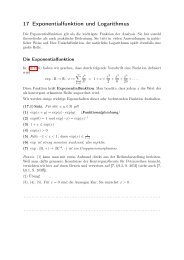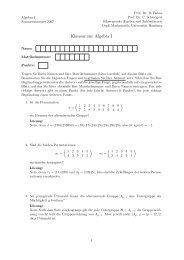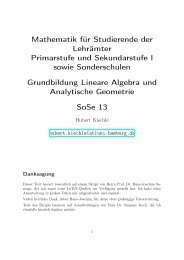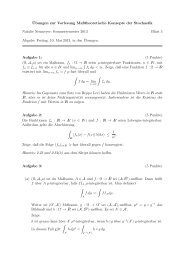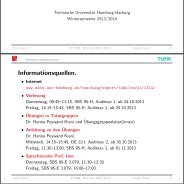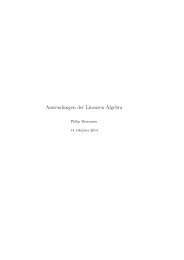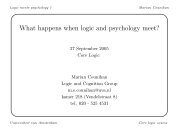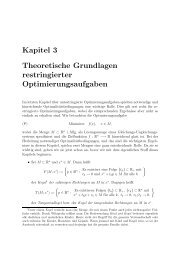pdf file
pdf file
pdf file
You also want an ePaper? Increase the reach of your titles
YUMPU automatically turns print PDFs into web optimized ePapers that Google loves.
The lemma implies that the u-algebra of a non-trivial restricted Lie algebra cannot be<br />
isomorphic, as a Hopf algebra, to a group algebra, since it contains no non-trivial group-like<br />
elements.<br />
Over fields of characteristic zero, we can recover a Lie algebra from the primitive elements<br />
in its universal enveloping algebra:<br />
Proposition 2.6.14.<br />
Let g be a Lie algebra over a field K of characteristic zero with an ordered basis and ι g : g → U(g)<br />
its universal enveloping algebra. Then<br />
P (U(g)) = ι g (g) .<br />
If char(K) = p, then the primitive elements of U(g) is the span of all x pk<br />
k ≥ 0. It is a restricted Lie algebra.<br />
with x ∈ g and<br />
Proof.<br />
Define<br />
and consider the direct sum:<br />
Since x ∈ g is primitive in U(g), we find<br />
U n (g) := span K {x n |x ∈ g}<br />
Δ(x n ) =<br />
U(g) ⊃<br />
n∑<br />
k=0<br />
∞⊕<br />
U n (g) .<br />
n=0<br />
( n<br />
k)<br />
x k ⊗ x n−k .<br />
Thus the direct sum is a subcoalgebra of U(g) and the coproduct<br />
Δ : U(g) → U(g) ⊗ U(g)<br />
preserves the degree. The right hand side is thereby provided with the total degree. One checks<br />
inductively using the Poincaré-Birkhoff-Witt theorem, that the direct sum is closed under<br />
multiplication as well (the multiplication is not homogeneous, though).<br />
We can restrict to homogenous elements<br />
to investigate the coproduct:<br />
Δ(x) =<br />
x =<br />
l∑<br />
j=1<br />
l∑<br />
λ j (x j ) n ∈ U n (g)<br />
j=1<br />
λ j<br />
n∑<br />
k=0<br />
( n<br />
k)<br />
(x j ) k ⊗ (x j ) n−k<br />
Then x is primitive, if and only if all components with bigrade (k, n − k) and 1 ≤ k ≤ n − 1<br />
vanish. Applying multiplication, we find<br />
( ) l∑ n<br />
λ j (x j ) n = 0 for all k = 1, . . . , n − 1 .<br />
k<br />
j=1<br />
Over a field of characteristic zero, this implies x = 0.<br />
✷<br />
52




